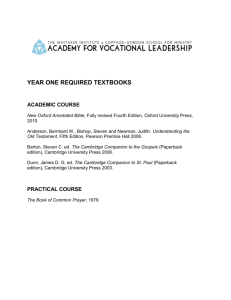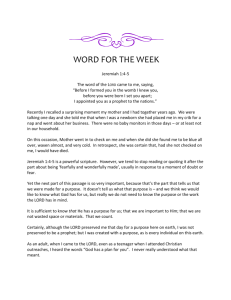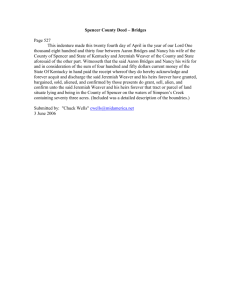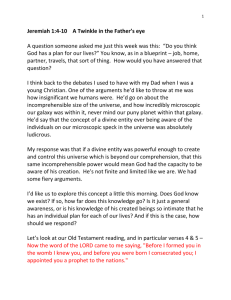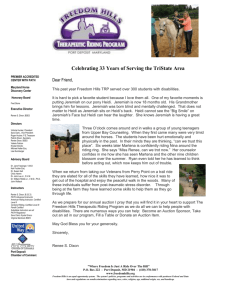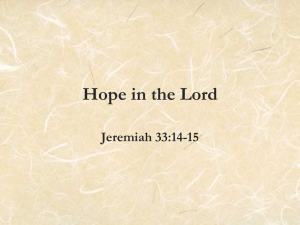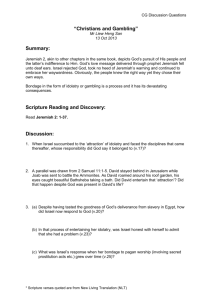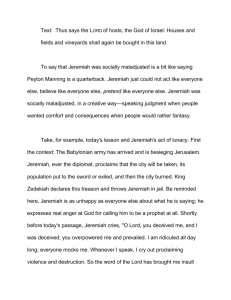Valid Text - James D. Price
advertisement
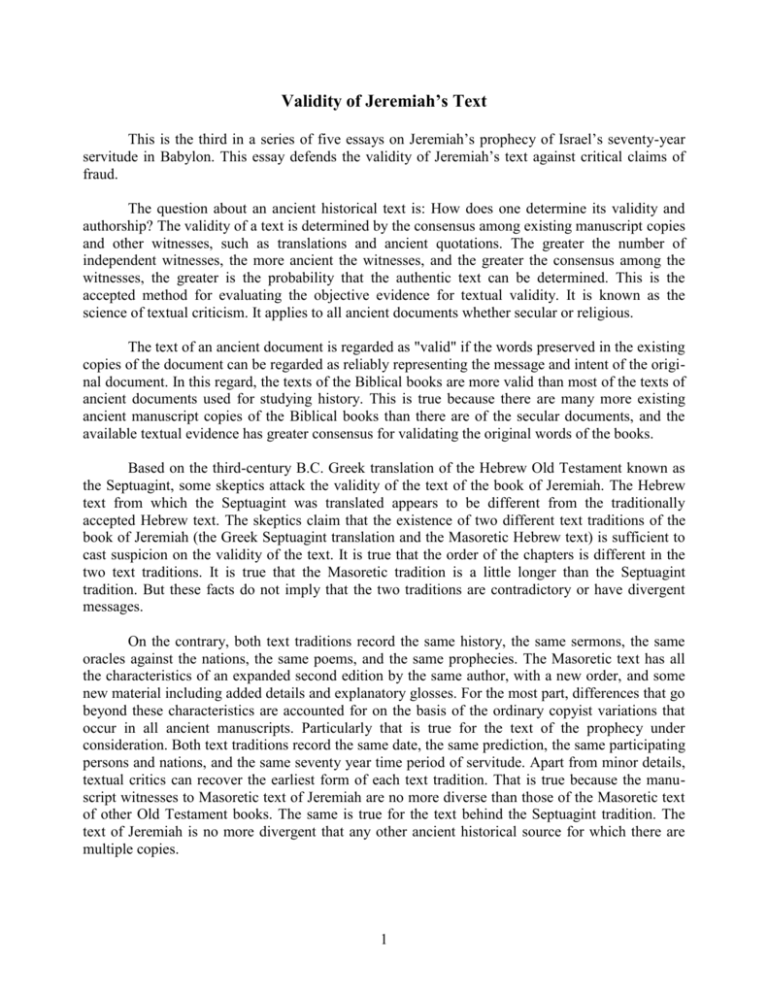
Validity of Jeremiah’s Text This is the third in a series of five essays on Jeremiah’s prophecy of Israel’s seventy-year servitude in Babylon. This essay defends the validity of Jeremiah’s text against critical claims of fraud. The question about an ancient historical text is: How does one determine its validity and authorship? The validity of a text is determined by the consensus among existing manuscript copies and other witnesses, such as translations and ancient quotations. The greater the number of independent witnesses, the more ancient the witnesses, and the greater the consensus among the witnesses, the greater is the probability that the authentic text can be determined. This is the accepted method for evaluating the objective evidence for textual validity. It is known as the science of textual criticism. It applies to all ancient documents whether secular or religious. The text of an ancient document is regarded as "valid" if the words preserved in the existing copies of the document can be regarded as reliably representing the message and intent of the original document. In this regard, the texts of the Biblical books are more valid than most of the texts of ancient documents used for studying history. This is true because there are many more existing ancient manuscript copies of the Biblical books than there are of the secular documents, and the available textual evidence has greater consensus for validating the original words of the books. Based on the third-century B.C. Greek translation of the Hebrew Old Testament known as the Septuagint, some skeptics attack the validity of the text of the book of Jeremiah. The Hebrew text from which the Septuagint was translated appears to be different from the traditionally accepted Hebrew text. The skeptics claim that the existence of two different text traditions of the book of Jeremiah (the Greek Septuagint translation and the Masoretic Hebrew text) is sufficient to cast suspicion on the validity of the text. It is true that the order of the chapters is different in the two text traditions. It is true that the Masoretic tradition is a little longer than the Septuagint tradition. But these facts do not imply that the two traditions are contradictory or have divergent messages. On the contrary, both text traditions record the same history, the same sermons, the same oracles against the nations, the same poems, and the same prophecies. The Masoretic text has all the characteristics of an expanded second edition by the same author, with a new order, and some new material including added details and explanatory glosses. For the most part, differences that go beyond these characteristics are accounted for on the basis of the ordinary copyist variations that occur in all ancient manuscripts. Particularly that is true for the text of the prophecy under consideration. Both text traditions record the same date, the same prediction, the same participating persons and nations, and the same seventy year time period of servitude. Apart from minor details, textual critics can recover the earliest form of each text tradition. That is true because the manuscript witnesses to Masoretic text of Jeremiah are no more diverse than those of the Masoretic text of other Old Testament books. The same is true for the text behind the Septuagint tradition. The text of Jeremiah is no more divergent that any other ancient historical source for which there are multiple copies. 1 Sixth Century Origin Some radical skeptics have claimed that the evidence does not support a sixth century origin of the book. However, for them to make that claim, they must disregard the dates in the text of the book, particularly the date assigned to the writing of that part of the book containing the prophecy under discussion. Jeremiah and his book are dated from the thirteenth year of Josiah's reign (627 B.C.) to the captivity in 586 B.C. (1:1-3). The prophecy under discussion is dated in 605 B.C., the fourth year of Jehoiakim (25:1). That is the same year that Jeremiah wrote the first edition of his book (36:1-4; 45:1) which clearly contained the prophecy under discussion (36:29). Other events are dated in the book.1 The text records that Jeremiah was commanded to write certain material,2 and that Jeremiah (or his secretary, Baruch) wrote certain material.3 For a skeptic to deny the sixth century date he must regard all these passages as fraudulent, something that he must prove, not simply allege. On the basis of objective evidence, the Septuagint translation is known to have been made in the third century B.C. So the Hebrew text behind the Septuagint translation must have been sufficiently well established in the third century for the translators to have regarded it as authoritative and worthy of translation. This places that text tradition at least in the fourth and likely in the fifth century. Besides the several hundred manuscripts of the Book of Jeremiah that date in medieval times, there are six manuscripts of Jeremiah from the Dead Sea Scroll collection that date in the first or second century B.C. Two of them are from the text tradition behind the Septuagint, and the others are from the Masoretic text tradition. Emanuel Tov, Editor-in-Chief of the Dead Sea Scrolls publication project, and a recognized authority on Old Testament textual criticism and one with no fundamentalist ax to grind, stated: "Between 1947 and 1956 fragments of more than 190 biblical scrolls were found in the eleven caves of Qumran."4 Most of these were fragmentary but with sufficient text to determine the textual tradition from which the manuscripts were copied. One may object that some of the manuscripts are fragmentary, as though reasonably sized fragments cannot identify the text tradition to which they belong. The existence of a fragment implies the existence of the whole book. For example, if the police find the skull and a few bones of a dead body, can they not legitimately conclude that the whole living body once existed? And cannot an expert biologist determine the original size, weight, race, gender, and general appearance of the dead person from the evidence available in the remaining fragments of the body? Cannot he study the DNA of these remains and determine its significant genetic codes? So also, textual experts can determine the textual family of a fragmentary text. If reasonably sufficient fragments of the Masoretic text exist among the Dead Sea Scrolls, then common sense admits the existence of the whole text. If the fragments confirm the essential details of the corresponding parts of the Masoretic text, then common sense admits that the missing fragments would also confirm the essential details of the text tradition to approximately the same degree of agreement. 1 28:1; 32:1; 36:9; 39:1, 2; 46:2; 51:59; 52:4, 5, 12, 28, 29, 30, 31. 2 22:30; 30:2; 36:2; 36:28. 3 36:4, 18, 32; 51:60. 4 Emanuel Tov, Textual Criticism of the Hebrew Bible (Minneapolis: Fortress Press, 1992), p. 103. 2 A complete Dead Sea Scroll manuscript of the book of Isaiah (1QIsaa) exists from the second century B.C., and it has about 95% agreement with the currently accepted Hebrew Masoretic text. From the same era, another Dead Sea Scroll manuscript of Isaiah (1QIsab) contains much of the text of 46 chapters of the book. This manuscript is almost identical with the current form of the Masoretic text. Tov listed a catalogue of the types of differences between 1QIsaB and BHS (Biblia Hebraica Stuttgartensia),5 the accepted form of the Hebrew text today: (1) Orthography (spelling differences) ....107 (2) Added waw conjunctive ...................... 16 (3) Lack of waw conjunctive .................... 13 (4) Article (added/omitted) ........................ 4 (5) Difference in consonants ..................... 10 (6) Missing letter ........................................ 5 (7) Different grammatical number ............ 14 (8) Differences in pronouns ....................... 6 (9) Different grammatical form ................ 24 (10) Different preposition .......................... 9 (11) Different words ................................. 11 (12) Omission of words ............................. 5 (13) Addition of words............................... 6 (14) Different sequence.............................. 4 That amounts to 234 differences of any kind "all of which concern minutiae."6 However, items 1, 2, 3, 4 and 14 have little or no effect on meaning, so they may be disregarded as insignificant. This leaves only 90 differences that may be regarded as of any possible significance. There are 66 chapters in the book of Isaiah, 1291 verses, 16,930 words, and 66,884 letters in the current Masoretic text of Isaiah. If the number of words in 1QIsab is estimated as 16,930 x 46/66 x .66 = 7,788 words, then 1QIsab agrees with BHS (7,788 - 234) / 7,788 = 97.0 %; or if the insignificant variations are excluded, the texts agree (7,788 - 90) / 7,788 = 98.8%. That is about the kind of agreement that any manuscript of the Masoretic text has. Regarding the Masoretic text in the era of the Dead Sea Scrolls, Tov, who is liberal in his approach the Biblical text, wrote: A similar analysis is suggested by Andersen-Freedman . . . in their analysis of 4QSamb, one of the earliest Qumran texts: “. . . insofar as there is nothing un-Masoretic about the spelling in 4QSamb, we can infer that the Masoretic system and set of spelling rules were firmly in place in all principles and particulars by the third century BCE.” Because of the meticulous care of those who were involved in the copying of [the Masoretic text], the range of differences between the members of the [Masoretic] group was from the outset very small. One should remember that the temple employed professional 5 Tov, pp. 31-32. 6 Tov, p. 31. 3 magihim, 'correctors' or 'revisers,' whose task it was to safeguard precision in the writing and transmission of the text.7 Such correctors or revisers were not responsible for altering the text, but for correcting or revising manuscript copies that varied from the official exemplar in their care. It was this meticulous care of the text that led scholars like these in the next generation to confirm that the Masoretic text was the authentic tradition. This places the textual tradition behind the Masoretic text at least in the fourth and likely in the fifth century. But the witness of the Aramaic translation known as the Targum gives good reason to place the Masoretic text of Jeremiah in at least the sixth century. Concerning the Aramaic Targum, Ernst Wurthwein, a recognized authority on Old Testament textual criticism, stated: "The Jewish tradition associating it [the Targum] with Ezra (cf. Neh. 8:8) may well be correct."8 Now the importance of the Aramaic Targum of the book of Jeremiah is that it was translated from a Hebrew text of the Masoretic tradition [Tov, p. 149]. If Wurthwein is correct, and there is no reason to doubt him, then the Masoretic tradition of Jeremiah was already well established as authoritative in the days of Ezra (fifth century B.C.). This gives reason to accept the sixth century origin of the book with little reason to doubt it. Not a shred of textual evidence exists that suggests that the date of Jeremiah's prophecy was ever altered. This is supported by several fifth or sixth century witnesses to the existence of the book, and the prophecy under discussion in particular: (1) the author of the Chronicles (2 Chron. 36:2223), (2) the author of Ezra-Nehemiah (Ezra 1:1-5), (3) the prophet Zechariah (Zech. 1:12; 7:5), and (4) the sixth century prophet Daniel (Dan. 9:2). These very early witnesses knew Jeremiah's book, and the prophecy under discussion in particular. All of these witnesses accepted Jeremiah as a historical person and the author of the prophecy. All regarded the prophecy as genuine, not fraudulent. In fact, Daniel read Jeremiah's prophecy before it was fulfilled (Dan. 9:1-2). This is evident from the fact that Daniel did not record the fulfillment of the prophecy--something that would have been significant to the content of his ninth chapter. I know that some skeptics reject the date and authorship of Daniel, and I am not interested in debating that question here. But there is no reason to late-date Daniel except for an anti-supernatural presupposition. In my own opinion, Daniel is a valid witness because his contemporary, the prophet Ezekiel, validated his date and existence (Ezek. 14:14, 20; 28:3). This does not include the mention of the prophet Jeremiah by the historian Josephus, the authors of several of the Apocryphal books,9 the Mishnah, and the Talmud. All these ancient sources regarded the prophet and his writings to be authentic. I have provided textual evidence for the validity and early date of the book that is far more numerous and relatively early than that for any ancient secular historical document. I have provided 7 Tov, p. 32. 8 Ernst Wurthwein, The Text of the Old Testament, Trans. by Erroll F. Rhodes (Grand Rapids: Wm. B. Eerdmans, 1979), p. 75. 9 Sirach 49:6; 2 Macc 2:1, 5, 7; 15:14, 15; 1 Esdras 1:28, 32, 47, 57; 2:1; 4 Esdras 2:18). 4 four very early, independent, reputable witnesses to the existence of the book and the prophecy. These witnesses were all recognized men of integrity, intelligence, and skill. None would have accepted the authority of a known fraud, nor would they have been a part of fraud. They would have known the textual evidence of their day, much like competent scholars do today. They would not have tolerated fraudulent tampering with the text. The Interpreter's Bible, which often supports the skeptics, alleges that the 25th chapter of Jeremiah was written by the "Deuteronomist" (D), a later scribe who added his material to Jeremiah's book. However, The Interpreter's Bible also stated that "the D edition of Jeremiah was made about 550 B.C. The man (or group) who made it may have lived in Egypt. D made use of the three preceding collections, adding his own work to them or revising them at some points."10 Note that the date assigned to the prophecy under discussion was in the sixth century, and almost twenty years before the prophecy was fulfilled. Even if one accepts the view of The Interpreter's Bible that the prophecy was written by the "Deuteronomist" nearly 20 years before its fulfillment, the prophecy would still meet the requirement of long range foresight, because foresight of 20 years is also beyond human expectation. Multiple Authors and Redactors The Interpreter's Bible, which often supports critical skepticism, asserts that the book of Jeremiah "is not the product of one person or of a small group of persons. It is the product of growth over a long period of time, to which many contributed." Another critic of the same stripe stated: "style, grammar, syntax, vocabulary, theme, and literary structure enable critics to recognize where redacting and editing occurred in the biblical text." Such statements are based on the underlying hypothesis that writers are incapable of writing in more than one style, vocabulary, theme, and literary structure. But just to articulate such a hypothesis shows how ridiculous it is. Only a literary clod would have such limitations. And if such a clod were to write something, who would publish or perpetuate his literature? Are we to assume that the great prophets of the Bible were literary clods? Who is to say that a given writer cannot not produce a variety of literature such as history, poetry, novels, biography, sermons, hymns, and theology? Would anyone dare to assume that such a writer would be limited to one style, vocabulary, and literary structure for such a variety? Any student of literature recognizes how artificial this hypothesis is. Indeed it is a mystery Why writers of ancient history Could never take the time To cast their thoughts in rhyme; And poets could never compose An essay in common prose; And a master of ornithology Could never write theology, But must use the very same words To write of God and birds. (JDP) 10 The Interpreter’s Bible, vol. 5, p. 788]. 5 According to John Bright, also a supporter if skepticism, some critical scholars identify three types of literature in the book of Jeremiah: (1) Type A consisting of prophetic oracles written primarily in poetry; (2) Type B consisting of biography; and (3) Type C consisting of prose discourses in a rhetorical style similar to Deuteronomy.11 According to Bright and other scholars of that ilk, each of these types was written by a different author. Type A is usually attributed to the sixth century prophet. Note that critical scholars really do believe there was a historical Jeremiah. Types B and C are usually attributed to later authors who added their material to the original work of Jeremiah--Type C being the product of a scribe or scribes of the Deuteronomic school. Of course, no one explains why the poet Jeremiah could not have written biography and prose; and no one explains how the disciples of Jeremiah, the early rabbis, and the educated Jews would have tolerated anyone grossly tampering with the original text of Jeremiah. No one explains how succeeding generations of scrupulous authorities would recognize the canonicity of a book if they knew that its text had been altered and that it contained fraudulent prophecies. Regarding the Type C portions, the type to which some critics assign our prophecy, Bright stated: Suffice it here to say that the style of these discourses, though indeed closely akin to that of the Deuteronomic literature, is a style in its own right with peculiarities and distinctive expressions of its own; it is by no means glibly to be classified as 'Deuteronomistic.' It is, moreover, not a late style, but a characteristic rhetorical prose of the seventh/sixth centuries. . . . Though it may well have undergone some verbal expansion after that time at the hands of editors and scribes, there is really no reason to place any of it (or anything in the book, for that matter) after the Exile.12 Although Bright is in general agreement with the critical approach to the book, he was honest enough to acknowledge its limitations: We are not, however, permitted to operate on this material by the methods of literary criticism, as if by peeling off 'non-genuine' accretions we could arrive at the 'genuine' words of the prophet. To attempt such a thing is a wholly subjective procedure. Viewed as literature, the prose discourses are a unity and are to be treated as such; they afford no stylistic canon for separating 'genuine' from 'non-genuine' words. On the other hand, to form a priori notions of what the prophet could and could not say, and then to attempt a separation on that basis, is indefensible and no more than a projection of the critic's own predilections. . . . In spite of undeniable verbal differences, the contrast between the Jeremiah of the poetry and the Jeremiah of the prose (and, one might add, between Jeremiah and the 'Deuteronomists') has been, by many scholars at least, badly exaggerated.13 11 John Bright, Jeremiah, The Anchor Bible (Garden City, NY: Doubleday & Company, Inc., 1965), pp. lxiii- 12 Bright, p. lxxi. lxviii]. 13 Bright, p. lxxiii. 6 In fact, some critics have identified the original "Deuteronomist" as Jeremiah.14 Beside the subjective nature of literary criticism, and the exaggerated manner in which critics evaluate differences, one has only to read the various critical authors on the analysis of the book of Jeremiah to observe one additional flaw: No two literary critics agree on the details of their analysis. In fact, it is not unusual to find the critics being very critical of one another. The Interpreter's Bible, which represents the critical view: "Though the subject has long been studied, there is no consensus among scholars as to the stages in the composition of the book of Jeremiah, or the process of growth by which it arrived at its present state."15 This type of disagreement is evidence of the weakness and subjectivity of the discipline as applied to Jeremiah. For a hypothesis to be eligible for acceptance there should be consistent agreement of the details when tested by different investigators. Concerning the test of consistency of details, the literary criticism of Jeremiah fails miserably. A claim of fraud cannot be proved by an appeal to the highly subjective, overly exaggerated, and contradictory evidence from literary criticism. Altered Text The claim of fraud includes the allegation that the text of Jeremiah was altered after the Exile in order to make it appear like a prophecy had been fulfilled. Of course, the only evidence for this claim is the unverifiable subjective hypothesis of literary criticism discussed above. According to the skeptical view, this prophecy is part of the "Deuteronomic" segment of the book, and this segment was allegedly written after the Exile, and so after the fulfillment. However, critical scholar John Bright, as cited above, stated that from a literary critical point of view the "Deuteronomic" prose is from the seventh/sixth century and no literary reason exists to date it after the Exile.16 On the basis of the consensus of abundant textual evidence, there is no objective reason to doubt the validity of the text of Jeremiah. The allegation that the book was written by multiple authors over a long period of time lacks an appeal to common sense; it is supported by highly subjective literary theories whose advocates lack consensus. There is no objective reason to doubt that Jeremiah actually wrote the book and that he wrote the prophecy when he said he did. Critical scholars also claim that the duration of Israel’s servitude was not seventy years as the prophecy foretold. They also claim that other details of the prophecy were not fulfilled. The next essay addresses those critical claims. James D. Price 14 So for example, J. A. Thompson, The Book of Jeremiah, The New International Commentary oh the Old Testament, R. K. Harrison, Gen. ed. (Grand Rapids: Wm. B. Eerdmans, 1980), p. 44. 15 16 The Interpreter’s Bible, vol. 5, p. 787. Bright, p. lxxi. 7
